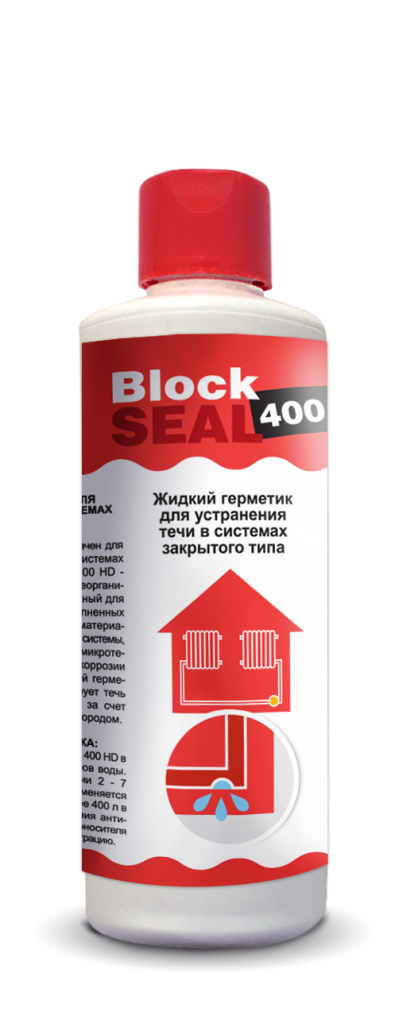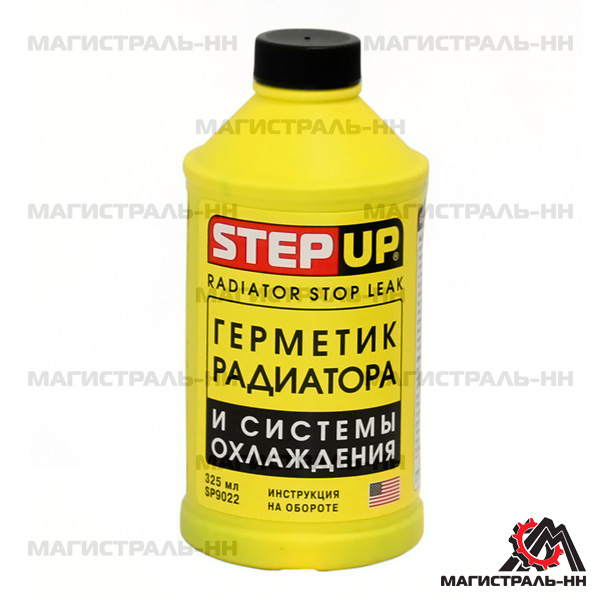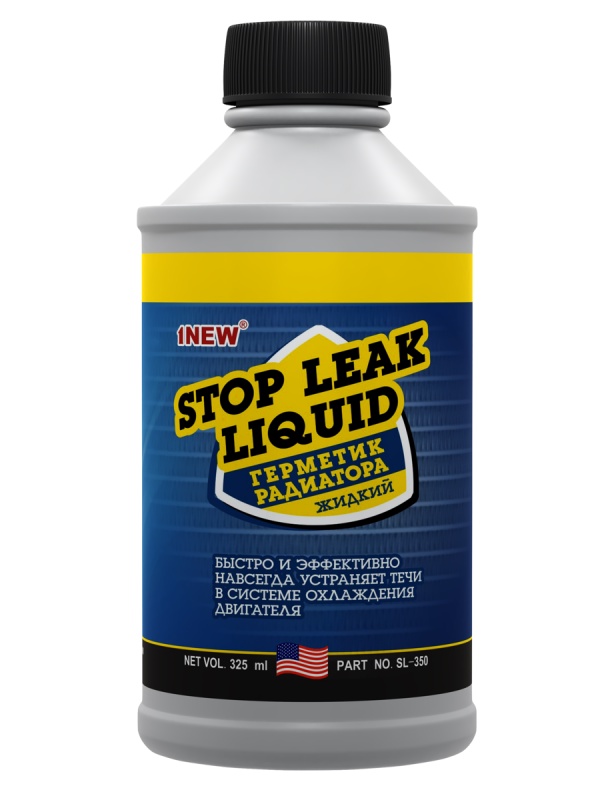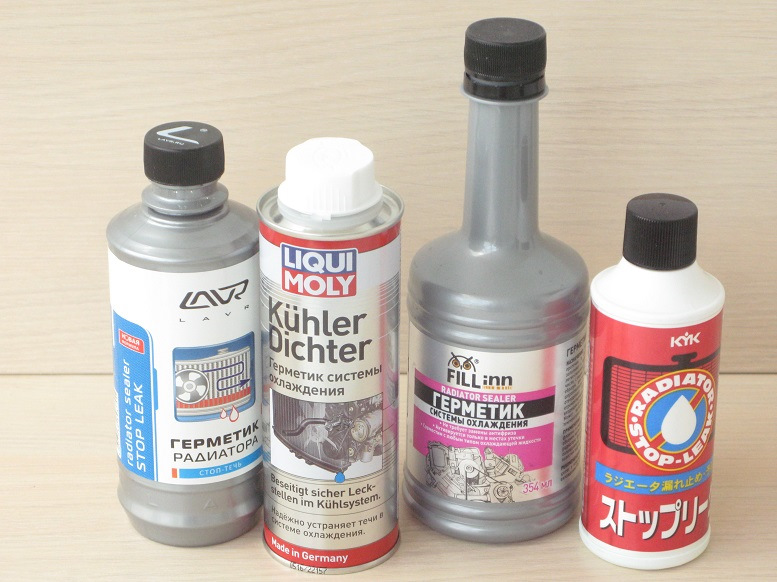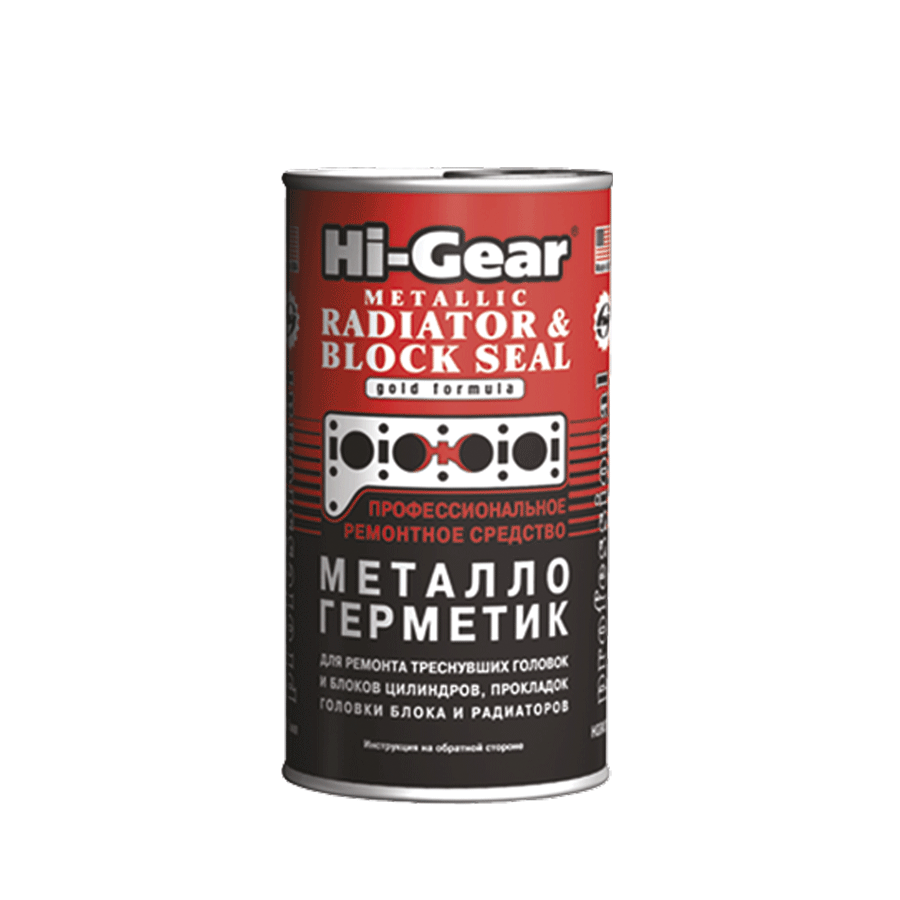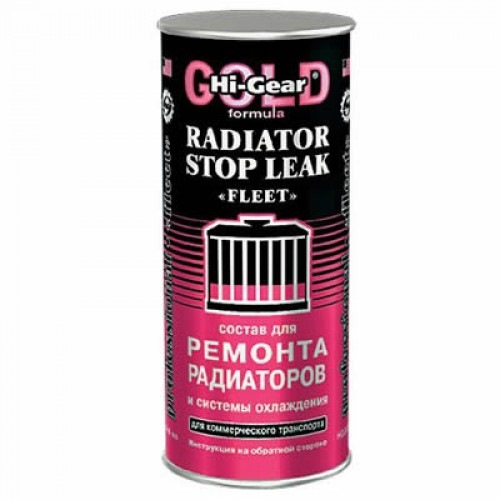Advice
To make a really high-quality repair, you should follow some advice on working with a sealant.
When choosing a liquid, you should carefully read its properties. Only knowing the composition of the solution and its purpose, it is possible to eliminate the leak, repair cracks, and obtain a durable connection. You only need to use the sealant that is suitable for this type of piping system.
Different sealants can act with different heat transfer fluids, this must be taken into account when making a choice
Some are intended for a heating system, inside which there is water, others operate in pipes filled with other liquids, for example, antifreeze, saline or anti-corrosion solutions.
Make sure the surface is clean and dry before starting work.
Before pouring liquid sealant inside the heating system, the amount of liquid that is planned to be filled must first be drained from the system.
Special attention should be paid to whether the product is resistant to high or low temperatures.
After applying the liquid, it is better to immediately remove all excess from the surface. The solution hardens very quickly, therefore, over time, its elimination will be almost impossible.
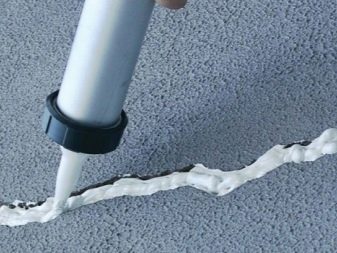
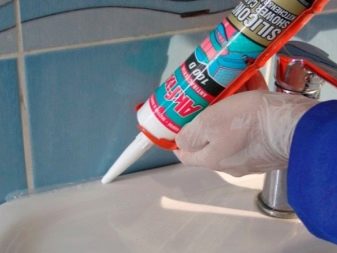
If a malfunction is detected in the heating system, before filling in the sealant, it is worth making sure that the expansion tank or boiler is working correctly. In the event of a malfunction, a decrease in pressure may occur, which can be mistaken for the formation of leaks in pipes, joints, and the boiler heat exchanger.
The solution begins to act on about 3-4 days. It is possible to determine that it gave a positive effect when the sound of water droplets inside the system disappears, the floor becomes dry, moisture will not form, the pressure inside the pipe will stabilize and will not decrease.
If the pipes are made with the addition of aluminum, one week after pouring sealant into them, the liquid must be drained and the pipeline must be flushed.
When working with liquid sealant, remember all safety rules
It is a chemical that requires careful handling. If the solution comes into contact with the skin or eyes, it is necessary to urgently rinse the damaged area with plenty of water.
If the liquid gets inside the body, you need to drink a lot of water, rinse your mouth and call an ambulance.
The sealant should not be stored near acid.
In order to dispose of the liquid sealant, no special conditions need to be observed.
If it is not possible to buy a sealant, you can try using mustard powder to fix the leak instead. To do this, pour it into the expansion tank and wait a few hours. During this time, the leak should stop.

For information on how to choose a liquid sealant, see the next video.
How to use: instruction manual
Many people make one mistake when using these formulations. This happens out of ignorance of the main functional component. But the function of sealants is very, very simple - to totally reduce coolant leaks during temporary use. Unfortunately, you won't be able to use radiator sealant forever. Reviews of motorists agree that the action of the drug can only get to the nearest service.
Operation may look like this - the driver pours the contents of a tube or bottle into the radiator, and then, after the car has driven into the garage or parking lot, it is necessary to immediately drain the coolant and thoroughly flush the system.

TOP 6 best radiator sealants
The products of all leading companies have been repeatedly tested by independent sources, so it is possible to compile a rating of the most popular products with sufficient accuracy.
BBF

Russian company engaged in the production of automotive chemicals. Produces various types of sealants, the best of which is BBF Super which shows excellent results when used. And its low cost confidently puts the product in first place in the “price-quality” rating.
The composition contains modified polymers, during operation forms a dense and durable white plug at the leak site.
The contents of the bottle are poured into the radiator of the engine cooled to 40-60 degrees, after which, when the stove valve is open, the engine starts and is brought to medium speed.
The smallest holes are fully tightened in 20 seconds, the maximum allowable size of about 1 mm will require up to three minutes of work. Sedimentation in the most unpleasant places, and these are the thin tubes of the stove radiator and the thermostat, were recorded only within the measurement error, as well as the change in the throughput of the radiators.
Liqui moly

The company is one of the pillars of the global automotive chemistry and petroleum products. Its rather expensive cooling system sealant is made on the basis of metal-containing polymers. It clogs the flow a little slower, but more reliable. It also does not have a harmful effect on other elements of the system.
It is interesting that the clogging rate of small holes is slightly lower, but the process is going confidently and for large defects the leakage time becomes a record in all tests. Undoubtedly, this is the merit of the metal components.
For the same reason, the product is able to cope with leaks into the combustion chamber. The working conditions there are such that it is the metal that is needed. The difference in the method of application is the addition of the composition to the radiator of the engine running and idling.
A high-quality and reliable composition, and as for the price, although it is higher than everyone else, it is small in absolute terms, and such drugs are not used every day.
K-Seal

Nevertheless, he coped with the task, the resulting seal is very reliable due to the metal content, that is, the tool can be used with confidence when unhurried work is required with a long-term result.
Hi-Gear

The alleged American-made Hi-Gear Stop Leak works a little differently than the products described above. Its distinctive feature is the ability to block even large leaks, up to 2 mm.
However, this comes at the expense of the risk of deposit build-up within the system. There was even an overlap of the standard antifreeze drain holes.
The accumulation of material in the plug is uneven, a lot of working coolant is consumed. The flow may resume, then stop again. We can talk about some danger of using this composition. The results are quite unpredictable.
Gunk

Also claimed to be of American origin. The action of the drug is not long in coming, the appearance of traffic jams is predictable and stable.
Of the shortcomings, the same danger of the appearance of harmful deposits on the internal parts and surfaces of the system is noted. Therefore, it is dangerous to use it on old cars with already dirty radiators and thermostats. Failures and reduced cooling performance are possible.
The opening hours are also peculiar. Small holes are slowly tightened, but then the speed increases, significant leaks are quickly eliminated.
Fill Inn

Cheap polymer sealant of domestic production according to American recipes. It copes poorly with large holes, but slots up to 0.5 mm, and these are the most common, eliminates successfully.
Medium risk of unwanted deposits. It can only be concluded that it is suitable for minor leaks.
OVERVIEW OF BEST SEALANTS FOR RADIATOR LEAKING
BBF SUPER

Universal sealing compound in the form of a liquid white emulsion, compatible with all types of antifreeze. One of the best on the market in terms of cost-effectiveness ratio. Manufactured in Russia and sold under the BBF trademark.
Super is used to repair small cracks and small holes in the cooling system of an internal combustion engine. It hardens when flowing out from the outside. Therefore, it forms plugs only in places of leaks. Does not harm parts and elements made of aluminum alloys, steel, cast iron, rubber and plastic.
+ Excellent value for money. + The lowest level of deposits among the tested. + High efficiency, the ability to temporarily remove both small (microcracks) and larger and more serious defects (holes).
LIQUI MOLY PRO-LINE KUHLERDICHTER K
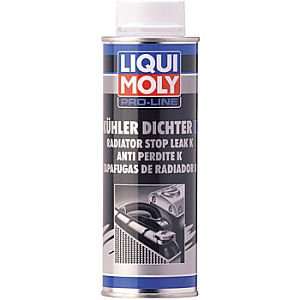
Automotive chemicals from a German manufacturer with more than 60 years of history. Reliable sealant for quick fixing of cooling system problems. Volume - 0.25 liters. Designed for 40 liters of coolant. Used in cases of leaks, hair cracks. Like the domestic composition "Super", it is distinguished by its versatility. Suitable for all car cooling systems, compatible with any antifreeze. Also, the Liqui Moly brand can be used for radiators made of aluminum alloys.
The preparation contains plastic chips and water-soluble monomer participating in the polymerization process. Do not adversely affect the heating circuit and water pump.
+ The most effective remedy in the test. - High cost.
K-SEAL PERMANENT COOLANT LEAK REPAIR

High-quality and expensive American liquid sealant, which is positioned by the manufacturer as a composition with a long duration of action. Suitable for eliminating leaks in a radiator, water pump, cylinder block (in places of gaskets, plugs).
It is a thick brown emulsion that mixes well with different types of antifreeze or water. The chemical contains copper powder, which is responsible for the formation of strong plugs. Car care products work effectively, but it takes additional time to fix large holes.
+ Low deposits + Good repair quality, but not the fastest + Ability to effectively deal with various types of damage - The guarantee of a long duration of action is questionable. - High price.
HI-GEAR STOP LEAK

Another North American auto-chemical, but less effective than K-Seal. Suitable for eliminating leaks in places where copper radiators are soldered, through thermostat or pump gaskets, radiator pipes, etc.
The composition of the fibrous consistency is blue-green. It copes well with the elimination of defects, including medium and large in size, but far from immediately. We'll have to wait and spend an extra amount of antifreeze.
+ High efficiency, forms protective "patches" even on large defects. - Slow operation. - A large amount of residual deposits, which will complicate the further process of flushing the system.
FILL INN

Autochemical product developed by the Russian company "Pride". It is a liquid sealant sold in a 354 ml bottle. Designed for cooling systems up to 10 liters. The drug is a white emulsion. Quickly enough eliminates depressurization of the internal combustion engine cooling system. Effectively fills micro cracks and other damage of minimal dimensions. Forms elastic plugs that hold well in place. Prevents corrosion processes due to special additives in the composition.
+ Low cost. + Excellent quality of work in case of micro-damage. - High concentration of residual deposits. - May not help with serious defects.
Radiator Sealant - Potential Problems
If you purchased a low-quality or fake sealant for repairing a radiator or did not fulfill the manufacturer's requirements, then instead of a leak, you can get other troubles as a gift. Namely:
- Thin radiator tubes can become clogged, the cooling of the engine is disrupted, which will lead to overloads or its failure.
- The radiator of the stove will also become clogged, and the heating of the interior of your car will become insufficient or stop working altogether.
- The pump may also break due to the abundance of foreign matter on the blades.
- The coolant thermostat will stop working and the engine will malfunction.
As you can see, a lot of surprises from driver's wrong actions can happen. Therefore, when buying a product, consult with the seller, carefully study the instructions and keep all receipts so that later you can find the culprit of your troubles.

And remember one important thought - you bought a car for several hundred thousand rubles, or even more, while pouring mustard into the radiator or using the cheapest or fake sealant is at least unreasonable. Repairing the engine or replacing parts of it will be much more expensive.
Home →
Operation → Auto chemicals and auto cosmetics →
What it is
Even before special products and automotive chemicals appeared, our grandfathers and great-grandfathers actively used one very spicy product called mustard.
No, they did not pluck the plant and put it into the heater radiator. They were interested in the powder version of mustard. According to some rumors, the practice of using mustard began in Afghanistan, during military conflicts. With leaks in the radiators, this powder was poured into the system, the engine was turned on and heated. Literally a few minutes later, the leak disappeared, and the car could move on. How long and far away, history is already silent here.
When dissolved, mustard powder literally plugged all the holes that it met on its way. After all, it is difficult to explain to an ordinary powder that it is necessary to close this particular hole, and not touch the other.

As a result, everything was clogged, starting from channels and bypass lines, ending with pipes, compensation holes, etc. The leak really stopped, but after that, flushing and often replacement were required.
Currently, motorists have switched to modern and more efficient means. But the meaning and essence of their application remained the same. Nobody falls asleep powder mustard anymore. Although the technique in many respects has echoes of the past. Such new generation products are called sealants.
Only here it is important to take into account that we are talking specifically about special sealing agents designed to work with radiators on cars and other equipment. It is strongly not recommended to take and pour construction sealant into the system.
Reading the reviews and based on the opinion of motorists, we can say that the sealant is a controversial and controversial thing. Some see only positive qualities in it. Others believe that it is better to never use them under any circumstances. And there is a third party that rationally approaches the assessment of strengths and weaknesses.

Rating of radiator sealants (best firms) - TOP 5
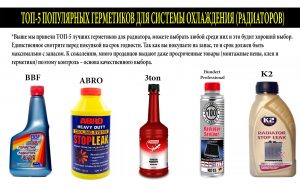 BBF. A popular and effective (according to reviews on the forums) sealant for the cooling system. According to the manufacturer, it does not clog the system and hardens only at the leak points. According to preliminary tests, it took the drug 20 seconds to close the leak from a hole with a diameter of 0.3 mm. The components of the sealant are safe for cast iron, plastic, rubber parts, steel and non-ferrous alloys.
BBF. A popular and effective (according to reviews on the forums) sealant for the cooling system. According to the manufacturer, it does not clog the system and hardens only at the leak points. According to preliminary tests, it took the drug 20 seconds to close the leak from a hole with a diameter of 0.3 mm. The components of the sealant are safe for cast iron, plastic, rubber parts, steel and non-ferrous alloys.
If the engine is hot, let it cool down to “warm” temperatures. Open the radiator cap, shake the contents of the bottle so that the sediment rises and pour it into the system. Can be poured directly into the expansion tank. We start the engine for 5-7 minutes, while the rotational speed should be from 2000 to 3000 rpm.
The BBF sealant is sold in containers of 325 and 500 ml. The cost varies up to 100 rubles (for 2019). You can find it in the catalog spare parts for the part number BBF5346.
Abro. Manufacturers describe it as a reliable remedy for leaks in cooling systems of any type. Works fast, works even with aluminum. Used in cylinder blocks, radiators, heating and cooling systems.
The composition of the ABRO sealant (Abro) has lubricating particles for coolant pumps and impurities from the corrosion of this unit. Available in powder and liquid form. The use of the product is similar to the previous one, so there is no point in repeating it.
Before use, it is recommended to flush the cooling system with an Abro flush (a special flushing liquid from ABRO), but if you are sure that the system is clean, then you do not need to flush it. Manufacturer - USA.
3ton Super. The brand positions itself as an effective tool that works where other sealants have not shown their effectiveness. Compatible with any type of coolant. The exact instructions for use are indicated on the packaging, be sure to read before use.
Hundert Professional. A product of the German industry. According to the manufacturer's assurances, it qualitatively seals any leaks of the cooling system, prevents the further emergence of new leaks, restores the elasticity and elasticity of the seals, is used at the service station by both amateurs and professionals. Seals cracks, stops leaks, and is compatible with all fluids in the cooling system.
The application is similar to the previous products. One bottle works with a system up to 10 liters. Made in Germany.
Radiator sealant K2. High-quality liquid sealant for heating systems, radiators. Works with leaks up to 0.9 mm in diameter in hoses, radiators, pipes, joints. The easy-to-use product restores the tightness between the cylinder head gasket and the oil seals. Protects against scale, rust, maintains free circulation of the system. Due to its properties, it lubricates the pump (pump), prevents its further failure.
Causes of oil leakage
Any automobile engine in the process of operation gradually loses its resource, which is expressed, among other things, in the wear of the oil seals or the appearance of backlash. All this can lead to the fact that the oil inside the crankcase can come out. However, there are actually more reasons why this can happen. Among them:
- deformation of rubber or plastic seals or their displacement from the installation site;
- wear of seals, oil seals, gaskets to the point where they begin to leak oil (this can happen both due to natural aging and due to the use of the wrong kind of lubricant);
- reducing the value of the tightness of the protective layer of individual engine parts;
- significant wear of the shaft and / or rubber couplings;
- increased backlash of the crankshaft or camshaft;
- mechanical damage to the crankcase.
Radiator sealant classification
Currently, the classification of sealants for eliminating leaks is formed according to two indicators: the consistency of the drug and its chemical composition.
So, there are two types of sealants:
- powder, which is a free-flowing mixture. Its microparticles, getting into the antifreeze, swell and settle on the surface of the radiator, forming a plaque at the point of leakage, which prevents the leakage of technical fluid. DoneDeal 6855, Kerry Kr130 020G, ABRO 404, Astrokhim AC179 can be cited as an example of powder agents;
- liquid, the principle of which is somewhat different. When in contact with air, they polymerize, forming a gel-like film, which is the agent that seals the damage. Such a sealant is removed by completely draining the coolant. The most popular liquid-type preparations: ABRO SL-624RU, MANNOL Radiato LeakStop.
Preparations of both types are available in the assortment of such well-known auto chemical manufacturers as HI-GEAR, StepUp, LIQUI MOLY.
By chemical composition, sealants are:
- silicone based on oxygen-containing components. This composition is characterized by high adhesive reliability and liquid consistency. The composition of sealants includes additives in the form of suspended solids. The activation of the composition occurs during interaction with the cooling liquid, while a sufficiently flexible sealing joint is formed;
- polyurethane sealants contain polymers classified as construction materials. Their advantage is the ability to work in conditions of significant temperature drops and the ability to withstand significant mechanical loads. The adhesion of the polyurethane composition is also quite high.

K-Seal Permanent CoolantRepair
Let's take a look at how to flush the sealant from a car radiator after using it. We have already spoken about the need to perform this procedure - plaque on the inner surfaces of the radiator and other components of the cooling system will prevent it from normal operation.
Often, simply draining the antifreeze does not give the desired result, therefore, special solvents are used that do this work as efficiently as possible. But it must be borne in mind that in this case, the damage that was temporarily sealed will reopen, so cleaning should be carried out in the place where the final repair of the damaged elements will take place (by tightening, soldering or replacing).
Such solvents can be both factory preparations and folk remedies. In particular, acetic / citric / lactic acid, Coca-Cola, caustic soda, or whey are quite effective. Among industrial preparations, we note LAVR Radiator Flush, LIQUI MOLY Kuhler Reiniger, Hi-Gear RadiatorFlush. But, again, in order not to harm the car even more, these funds should be used according to the attached instructions.
Eliminating the sealant - flushing the radiator correctly
Another important process is flushing the radiator from the sealant residues. It is done as follows:
- Cool the engine beforehand;
- Be sure to drain all antifreeze from the system;
- Pour the flushing agent of your choice into the system itself;
- Drain and warm up the engine. Leave it empty for half an hour.
- Thoroughly flush the system after cooling the engine by filling it with distilled or simply filtered warm water. Let the engine idle for the next ten to fifteen minutes, then drain the water. If necessary, the procedure can be repeated.
- You can fill in new antifreeze.
If the instructions for your product are different, it is worth using them to avoid problems and malfunctions.
Radiator sealant rating
There are no rigid domestic and world standards, regulations, technical and resource tests of the properties of sealants for radiators.
To compare the performance of repair additives, a technical inspection section of the pipe is usually used, in which holes of different diameters from 0.2 to 1 mm are made. This area is fixed on the model between the radiator and the water circuit.
After running the fluid with each of the additives, measurements are made of the clogging rate of the defect, the mass of plaque deposits and the state of the aggregates after draining the antifreeze.
Comparison of the results showed:
BBF
Russian-made polymer emulsion Cost from 70 rubles. for a bottle of 325 ml. Traditional way of using. Pour into the radiator hole with the engine off. Then let the motor idle for 10 minutes. During the tests, the control holes were sealed in accordance with the size gradually from 0.2 to 1 mm. As a result of measurements, he created neat adhesions at the leak points.
It took 20 seconds to seal the smallest hole, the largest a little over 2 minutes. Showed the smallest plaque mass after measuring the layers. Good performance for a small budget. High efficiency and lowest negative impact on the radiator.
Liqui moly kuhler dichter
German sealant. It can be used in units with aluminum elements. Its price: from 300 rubles. for a bottle of 250 ml. It is poured into the expansion tank when the car engine is running. Compatible with any anti-freeze compounds
The adhesion speed on the damage is proportional to the size from 32 sec. up to 2 min. When measuring deposits on the elements of the bench apparatus, it showed an average value.
The cost is justified by the performance and quality. Fastest seam formation rate.
K-Seal
An American lineup that you rarely see on sale. The radiator additive contains powdered crushed copper. There is such a sealant from 650 rubles. for 300 ml.
Relatively quickly formed a protective plug on small holes: a 0.2 mm diameter plugged in 35 seconds. It took more than 6 minutes for a 1 mm gap. After draining the antifreeze, the plaque on the surface of the elements did not exceed the average value.
Unreasonably high price compared to efficiency.
Hi-Gear Radiator Stop Leak
American-made radiator sealant. Not aggressive for elements made of copper, aluminum, plastic.
Its cost is from 350 rubles. Available in 325 and 440 ml.
At the same time, it has created a hermetic protection of all wells, regardless of size. It took a little less than 2 minutes. But the seam was found to be unstable on larger cracks. He formed a stable joint only after 10 minutes. Measurement of the mass of sedimentary layers on the bench unit revealed high deposition rates.
Strong but inherently unstable seal. May block the drain.
Gunk Radiator Sealer Super
The gel-like polymer compound is also from an American manufacturer. Sealant for use in brass, aluminum and composite radiator systems. Used with all types of antifreeze. It is added to the radiator when the car engine is running. Its price: from 400 rubles. for 440 ml.
On bench tests, showed average adhesion speed on damage. For a hole with a diameter of 0.2 mm, it took more than 2 minutes, a diameter of 1 mm was tightened in 3.5 minutes. Measurements revealed high sediment values
Should be used with caution in high-mileage vehicles
Gunk Radiator Sealant contains components that can be harmful to health if they come into contact with mucous membranes.
Fill inn
A young brand of a domestic manufacturer. The manufacturer positions its products as specially designed for Russia and the CIS countries based on foreign components. Such a composition costs from 60 rubles. for 350 ml. The method of use is classic (with the engine off).
It took 10 minutes for a tight adhesion of holes up to 0.8 mm. The slit with a diameter of 1 mm did not close after 20 min. Measurements revealed the highest plaque weight after testing.
The main advantage of this engine cooling system sealant is cost.
After 10 hours of loading and circulation of liquids of all sealants in the bench circuit, not a single hole has leaked.
Sealants for the internal combustion engine cooling system: principle of operation and features of choice

A sealant for the engine cooling system is a special tool that allows you to eliminate minor cracks and other defects in pipes and pipes. A large number of such elements with thin inner walls are the basis of the basic elements of the internal combustion engine cooling system. We are talking about a cooling radiator and a heater radiator.
So, let's begin. Many experienced car owners have been familiar with one means of dealing with a sudden radiator leak for more than a dozen years. This is ordinary mustard, or rather mustard powder.The specified powder is poured into the radiator, after which small cracks are clogged from the inside. This method was actively used on domestic cars with brass radiators, it was used on cars with an aluminum radiator, etc.
Note that although the mustard made it possible to temporarily eliminate the problem, the risk that the radiator cells, cooling system channels, and stove radiator tubes would clog up significantly increased. As a result, after such a "repair", it was necessary to get to the car service as soon as possible, qualitatively eliminate the cause of the leak or change the defective element, then flush the cooling system and replace the coolant. In some cases, it was also necessary to replace the thermostat.
How sealants work to fix radiator leaks

Now let's return to sealants, which are a modern way to solve this problem. The principle of operation of such formulations is similar to mustard, that is, it is based on the "tightening" or clogging of the crack. At the same time, manufacturers promise minimal risks for the cooling system itself. In parallel with this, it should be borne in mind that such special equipment can be both high-quality products and an outright fake. In other words, cheap sealants may in fact turn out to be not a special composition, but all the same mustard, flour, construction glue, etc.
After the application of such means, the tubes may become covered with a layer of sealant, the cross-section of the internal channels will decrease, as a result of which the passage of antifreeze may partially or completely stop. Most often, the stove radiator becomes clogged, the heater stops heating, and the cooling radiator overheats significantly. It turns out that a low-quality sealant can lead to overheating of the entire engine.
Given that there are a large number of such products on the market, you need to be careful when choosing. Moreover, there are no norms, standards or special methods that allow you to check the sealant and its quality.
For this reason, it cannot be said unequivocally that the best sealant will be a product of an exclusive brand. Let's figure it out.
We add that after the final elimination of the leak, that is, in the case when the sealant has completely coped with the task and about 20 minutes have passed, there is usually no rapid resumption of leaks. This means that theoretically, a high-quality vehicle can be enough for both tens and hundreds of kilometers.
- Analysis of the efficiency of the cooling system itself after using the sealant also does not reveal significant deviations from the normal mode. Antifreeze does not react with the composition, the thermostat does not jam, the engine temperature does not rise above the permissible operating range. It turns out that a high-quality product does not do much harm to the system. In parallel with this, any sealants still affect the elements of the cooling system. Different agents, to a greater or lesser extent, settle on the walls of the tubes and the surfaces of parts, the hydraulic resistance to the coolant flow changes. In short, deposits in the cooling system appear on the pump, in the channels of the cylinder block and on the walls of different tubes, but the overall performance of the system is not affected.
- After using sealant, you should expect possible consequences in the form of clogged drain holes when draining antifreeze from the system. The indicated holes have to be mechanically cleaned for the normal drainage of the working fluid.


